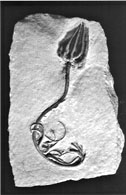|

Comment
on this story
What:
Burgess Shale: Evolution's Big Bang
Where:
UT's McClung Museum, 1327 Circle Park Drive
When:
Through Dec. 1. Call 974-2144 for information.
|
|

The Burgess Shale fossils reflect a big bang on Earth
by Heather Joyner
First came the Big Bang, an unfathomable 10 billion (give or take a few) years ago. Six billion years later, the Earth was formed. Then, just 3.8 billion years ago, life appeared here. And a mere 500 million years or so ago, our little planet experienced its own blast of evolutionary activity called the Cambrian explosion—a relatively sudden appearance of various animals beyond one-celled organisms. Thanks to the discovery of what is called the Burgess Shale, we know many of those early animals and how they functioned.
Picture a lean older man perched on the slope of a Canadian quarry. It is 1909, and paleontologist Charles Doolittle Walcott stares out from British Columbia's Wapta Mountain at a world teeming with life and evidence of lives past. Having found the mother lode, he looks intense and triumphant. The expanse of shale he's excavating, called the Burgess Shale (named for a colleague), represents the most complete record of the Cambrian period thus far.
Burgess Shale: Evolution's Big Bang, a small traveling show that will move on to a number of institutions throughout the next four years, is now at the McClung. Although the fossils presented are fascinating, they leave us wanting to see many, many more—luckily, Geology and the Fossil History of Tennessee is also on view. In my mind, Burgess Shale lacks the usual oomph of McClung fare in its display design and breadth of material. But like the museum's other exhibits, it's worth a stop (as the herd of school buses there the day I went might attest), even if displays touted as interactive are more manual than high-tech—with a sort of elementary Pat the Bunny feel. Rotating pictures and text accessible via slot machine-style cranks may not be what we'd find at a slick science discovery center, but there's something to learn nevertheless.
In fact, regarding advances in paleontology, one refreshing Burgess Shale placard reads, "None of these [new] approaches relies on computers or elaborate technology. Eyes, brains, and perseverance are still the best tools for the job." And it seems that "eyes" heralded a giant leap forward in the realm of multi-celled animals. With the ability to see, such creatures could do more than slink around and suck at the ocean's bottom. Hunting was born, and the hunters assumed some rather astonishing forms.
An illustration labeled "What scientists think the sea floor might have looked like 505 million years ago" features organisms milling about underwater. With odd hose-ish appendages, sleek carapaces, and spiny extensions, they appear as BattleBots ready for action. Odder yet is the idea that Pikaia "worm-like primitive chordates of the phylum that includes mammals" may represent the very origins of us all (if the 1925 Tennessee legislature found the monkey connection distressing, just imagine their outrage at the notion of descending from a critter resembling a space-age Electrolux). Given names like "hallucigenia" and "wiwaxia," soft-bellied animals similar to velvet worms likely emitted flashes of iridescent color. There's even "marnella," a lacy anthropoid dubbed "the Cambrian cockroach" for its omnipresence throughout rock from that period. It's all pretty trippy.
As for Walcott, President of the National Academy of Sciences and Secretary of the Smithsonian Institution when he made his Canadian Rockies discovery, it's interesting to see photographs of a genius at work. That someone could identify a wide range of specimens as well as determine their behavior is impressive indeed. Interpretations of fossils change, but many of Walcott's suppositions remain undisputed.
Periods like the Cambrian (related to Cambria, the Roman word for Wales) are named for places where rock with fossils from a specific time can be found. Furthermore, specific discoveries can be named for other people, but not one's self. The McClung exhibit's map showing landmasses clustered near the equator during the Cambrian era calls those masses "Gondwana," "Baltica," and "Laurentia"—where Greenland and the Burgess Shale are thought to have once been located. Another display reveals a "body plan" and reflects the basic "architecture" that "makes a bird different from a butterfly or a starfish different from a crab." Surprisingly, despite the complexity of the information, it's made fairly palatable and relevant to a range of visitors.
Copied pages from Walcott's field notebook are a bonus, too, although they're somewhat mundane—noting weather conditions, logistics of pack horses and assistants, etc. But when we behold objects like the fossil of a Trilobite Olenoides in all its magnificence, we begin to imagine the thrill it must have given Walcott and his crew. And it's an experience we can share, to an extent, at the McClung in coming weeks.

October 3, 2002 * Vol. 12, No. 40
© 2002 Metro Pulse
|